Text
Westworld Analysis
The opening is like a delicate artwork. Everything is pale, sentimental, and solemn, suggesting the concept of “creation”. It starts from a mechanic hand producing and connecting a piano string, then turns to it creating and pulling a muscle fiber. It is a clever hint that the android hosts, or “robots” in the Westworld are just like pianos, and this metaphor runs through the whole story. Just like building an piano, hosts are made in a purely cold, mechanical way. But the creation is lively as it shows a running horse. Without skin, the white model runs with vitality and elegance. Then the machine hand is creating an iris of human eye. Not only animal, as it suggests, hosts are also given physiological functions, as the pupil narrows and reflects the scene of a wild west scenery, which is the stage of the Westworld. What’s more, the scenes of hosts playing the piano and having sexual intercourse even imply that hosts may have the artistic ability and sexual desire as humans do. Next, the image of gun, machine and face which only half is covered with skin suggests the main elements of the Westworld park. And as a female host rides the horse, holding a gun in her hand, a system is finally build. But when the host’s hands leave the piano, the piano still plays. The stunning scene of piano plays by itself makes the truth even more meaningful and thought-provoking: it is a player piano that is actually programed by the music roll. Here comes the metaphor again, that the paths of the hosts are determined as narratives like music rolls; though hosts may think they are “playing their own music”, indeed they are just following human’s order, trapped in a loop created under technology. In the opening there is a strange calmness that dominates; everything is moving in an elegantly ordered way, which even seems somehow terrifying. It invites the audience to think about those beautiful creations: they are flawless, pure, with translucent gloss. What makes them different from human beings? Are they less than, or more than us?
The opening sequence seems random, but is in fact a work under meticulous design. Every image goes step by step to reveal the main theme of the episodes. From creating instrument to create android, from having life to implying higher consciousness, the opening follows a logical order. There are also many details worth noting. Besides the piano mentioned above, the eyes that reflect the scene also contain deeper meaning. It not only serves as a way to connect the hosts with the Westworld, but also challenges the value we put on eyes. We believe eyes are the windows to someone’s soul. They are something that are emotional, or even somehow divine. But the eyes of the hosts are created by some kind of chemical liquid material under a needle. It is purely manufactured in “dirty” industrial way. But those eyes are still bright and beautiful. The existence of soul is blurred, and it again questions the difference between we creators and our creations. The final scene, in which the host model is installed in a circular machine, which looks exactly like Da Vinci’s anatomical drawing, The Vitruvian Man. Da Vinci used The Vitruvian Man to suggest how human is related to the cosmos, to some universal truth with transcendent meanings. But the Westworld takes it to a totally different approach. The man in the circle gives a cold machinery feeling. It is no longer a coincidence that reveals some higher meaning, but a mechanical creation under calculation. In some ways, the opening has this intention in trying to challenge and redefine the notion of human and machine, which I believe is the main theme running through the Westworld. In the Westworld, which is an amusement park, hosts are created and designed as the natives of this place, and players come to satisfy their desires by interacting with the hosts. It is said to be a place where players can “find their true selves”, but it is also a place where primitive instinct is unleashed, and what indeed happen is the savoring of promiscuity and slaughter. There are certain rules to ensure the experience of the players: the hosts cannot kill the players, but players can do anything they want to the hosts; whenever the hosts are malfunctioned or “dead”, the staff of the park will repair and refresh them, and put them back to the narrative they belong to. Many hosts are living in a loop that they get fucked or killed everyday, living a same life with same ending over and over again.
Dolores and his dad, Peter Abernathy are two of the hosts. Every morning, Abernathy will sit in front of his house, have some little chat with Dolores, graze horses in his farm, and get killed by some robbers, who are hosts too. And Dolores will come to the Sweetwater town and drop a can on the ground. But one day, at one loop, Abernarthy accidentally finds a photograph of a woman of the real world. Things change then. Since Ford, the founder of West World Park, launches an update with “reverie” code, which allows hosts’ memory to persist to some subliminal level, Abernarthiy think deep in to this photograph. On the contrary to what Dolores respond to the photo, which “doesn’t look like anything”, Abernarthy appears to be extremely curious, that he doesn’t sleep for the whole night. Triggered by code malfunction and memory resurrection, Abernarthy realizes the truth of the Westworld. However, the manger finds the aberration in him, and he is interviewed by Ford. It is suggested that Abernarthy somehow gains access to his previous builds, as a professor and the leader of a cannibalistic cult. And when Ford asks, “What is your itinerary?” He answers, “To meet my maker.”
Ford continues, “And what do you want to say to your maker?”
Abernarthy replies,“By most mechanical and dirty hand, I shall have such revenge on you both. The thing I will do. What they are, yet I know not, but they will be the terrors of the earth. You don’t know where you are, do you? You are in a prison of your own sins.”
To me, this is the most astonishing moment of this episode, showing a mind that’s finally awakening. Some how he shapes himself a new character based on his past builds, and his thoughts and mind are no longer under the control of his creators. It is hard to say that he is just a robot.
In terms of Dolores, she is a even more complicated character. But she is so mysterious that we don’t know much about her. From the information provided, Dolores is the first host, which leads to question that there may be something special about her. In a interview, when Stubb asks Dolores, “have you ever lied to us?”, Dolores’s answer is “no”. Stubb then questions, “Would you ever hurt a living thing”, and she answers, “No. Of course not.” But in the ending scene of the episode, when a fly settles on her neck, which is a living create that she has no response to previously, this time she kills it. She is still smiling, as she was answering the questions of interview. Was she lying to the staff of the park? Did she understand what Abernarthy was trying to tell her? I can’t be sure. In the first minute of the episode, she was questioned by Bernard: “have you ever questioned the nature of your reality?” And she answers, “no.” She is in a system that everything she sees or hears is under control, that she believes it is her own path. It is a cruel fact that reality is built on the signals of the brain, and Dolores’s answer would determine if her brain is still under control or not.
There are many things that may be hints to some hidden facts. Like, what is the purpose of “reverie”? Is is in relation to the “true purpose” of Ford? Did Ford foresee the consequence of this update that he did it by intention, or it is a pure mistake? What is the man in black seeking for? What does Berdard whisper to Dolores and Abernarthy? It is hardly possible to distinguish hosts from humans. Since there is some strangeness in Bernard’s character, is he actually a host? Then what does it mean for a host to analysis other hosts? It is hard to tell without watching all the episodes, but all these clues lead to something further. There is some kind of unsettling feeling growing in the Westworld. It is the inevitable outcome when consciousness is about to surface. Killing the fly is a symbol of an upcoming change.
0 notes
Text
Response to “We’re Building A Dystopia just to make people click on Ads”
There is a saying: “we are the sum total of our experiences.” Then what if over experience can be manipulated under the careful calculation of some kind of intelligence- does it mean that we are controlled? What if what we see and hear everyday are intentionally inducing us, or even shaping us? It is not just imagination, it is happening. It happens when we shop in Amazon, we use Facebook or Instagram- when we are online.
As techno-sociologist Zeynep Tufekci suggests in her “We’re Building A Dystopia just to make people click on Ads” talk, there is an algorithm established by the company to conduct their intentions: whether to sell us products or ideas. To me, I think it is the truth.
I used to treat online ads with scorn. Like the example Tufekci says, you “look up a pair of boots and for a week, those boots are following you around everywhere you go. Even after you succumb and buy them, they're still following you around”. It is stupid. But somehow artificial intelligence is actually much more stronger, or our mind is weaker that what we have imagined. The most powerful influence never lies on the surface, but goes deep down into our subconscious mind. Many times, we do see some images, but we don’t really “see” it. We just skim over it. We are not trying to interpret it, but it goes through our eyes and remains in our brain. It is a process that we don’t have control over. And one day, that image which lies deeply will revive and leads us to a make a choice.
About a month ago, one day I felt like to go to the cinema. I didn’t know why. I neither knew what was on the screening list at that time, nor I had a specific movie in mind. But on that day, I had this feeling: “I have to go to the cinema and watch a movie.” I was not bored and I got things to do, but this feeling was so strong that I couldn’t get away from it. Finally, due to the money problem, I suppressed myself from purchasing a ticket, but when I was browsing the website of AMC, I realized that it was the date when Deadpool 2 was released. I had no idea why I would remember the date; I did like Deadpool, but I had no memory about its sequel. All I had were some vague images in my mind. May be it’s an image on Instagram which I scrolled up and ignored; maybe it’s a short ad before a youtube video and I just skipped; maybe it’s a poster I skimmed through on Tumblr. I didn’t know, but something did remain.
The fact that we are seeing what someone makes us to see can be frightening. For most of the times, we are just passive receivers of information. Sometimes, we even have opinions towards things which we believe we never saw, heard about, or knew in real life. But the truth is: we actually did. Maybe just a water drop in the ocean of information we received, it somehow stayed in our brain; And somehow it can influence us, control us, and forms our prejudice, even though we didn’t realize it.
This phenomena is the inevitable outcome of market and commerce. I believe that thinking critically is the only raft we have, as we are surrounded by this ocean of hints and cues.
0 notes
Text
Black Mirror-Playtest
“What is real? How do you define real?”
I still remember the question thrown up by Morpheus in the Matrix. I think Playtest also possesses this philosophy. Whether in the world of Playtest or the world of we audience, reality is not a solid concept we can prove; Playtest explains this idea in a more impressive, somehow more apparent way.
In Playtest, the protagonist, Cooper leaves his home and travels around the world. He hooks up with a girl named Monica. From their conversations, Cooper mentions that his father is dead of Alzheimer's disease(AD), and he doesn’t know how to talk to his mother; his mother has been calling him many times, but he never answers. Next day, he finds out that his credit card is hacked and he has no money to move on, but still he choose to call Monica instead of calling his mom. To make some money, under the instigation of Monica, Cooper signs up for a game test of SeitoGamu, a large game company. It is a game that connects to the brain of the player, Cooper, and explores the deepest fear of him. Just like Matrix, what Cooper sees and feels in the game is not “real”. Everything in the game is the reflection of Cooper’s mind. Entering the game set, the first fear he encounters is a spider, and he crushes it; then he sees his bully classmate in his high school wearing a creepy suit- after finding out that what he sees is not real, he dares to “talk” with it or even touch it, but he begins to feel nervous; the next level is a monster spider with the face of his bully classmate which frightens him and makes him feel angry. These three don’t hurt him for real. In my understanding, these fears are superficial which are based on visual images. However, the forth level, where Monica shows up and tells him that it is her scheme to let Cooper play the game; she even stabs Cooper in his shoulder and turns to a monster. Cooper is in extreme fear and pain, and after finding out it is game effect again, he turns mad and wants to quit. This level is more towards reality which stems from his lack of security towards the world around him. His disbelief of Monica and SeitoGamu is all reflected and embodied in this phase. It is no longer the fear which lies on the surface, but something stronger and deeper. Next stage, after Cooper follows the instruction and goes upstair, he is told that there is no way out. Soon he feels despair; he can’t think rationally, and gradually he loses his cognitive ability; even memory fades away. He is just like his dad who suffers from AD. The great anxiety and helplessness due to gradually losing his mind and control over things is what he sees in his father’s life. He becomes hysterics.
Suddenly it is uncovered that the final level is also part of the game test. After escaping from it, he determines to go back home and faces his problem with his mom. Back when he finally comes back, what he afraid the most happens. His mom can’t recognize him. After calling Cooper over and over again without his answer, she catches AD too. Cooper crushes down. The fear interwinds with conscience and shame finally drives him crazy, and finally kills him.
However, it is also one layer of the game. Cooper died, in 0.04s of gaming time. It is said that the call from his mom interferes with the equipment and causes his death.
Playtest ends here, but a strange feeling goes on in my mind. It is real, or a layer of the game? When did the game really start; is it end yet? It’s like a dream, and you never know when dream started. The reality becomes hard to tell. From a physical reality to an augmented reality, things are apparent and there is no problem, just like playing a VR game. But from an augmented reality to hyperreal, things change dramatically. Cooper can no longer distinguish game effects from reality. He can’t read his own experience anymore; even time is altered in the game; the mental reflections become true tragedies which crush him and kill him.
When a game has characters that are visually real but also just visually real, is it still a game?When a game has props and characters that are “real” in all senses, is it still a game? When a game can enter your brain, get in touch with the deepest memory of you, and manipulate people who we know in real world, is it still a game? The answer changes.
Like Morpheous said, reality is just “electric signals that interpreted by your brain”. A extremely advanced game finally becomes reality; or can we say, the physical reality is a higher level of game?
0 notes
Text
Me and my Instagram
Seeing that someone liked my painting in Instagram can always cheers me up. I was always waiting for this moment when the little window of notification jumps up on my screen, and I can’t get enough of this; I’m addicted to it. And sometimes, when I posted something, and for a long time there is no pop-ups from Instagram, I feel upset and restless. I believe that I get sick with Instagram, which no longer seems to be a simple application to me. How can I be this way? For real, what does Instagram mean to me?
I remember when I first signed up for Instagram. It was when I was studying in a poor art department of University of Illinois. My instructor introduced some artists and helpful resources to me as he said, “follow them on Instagram and you have them with you all the time”. It did help me a lot. Many drawings and paintings inspired me, and the short videos of artists’ working process always encouraged me to work harder. I didn’t post anything on my Instagram at that time: I was no one with no profile photo or description. No one followed me either, and Instagram is more like a reference book for me.
Things changed when I followed my friends. I started to see their recordings of their daily lives: where they went for lunch, what they did last night, or what they saw at some very moments. These posts give me a strange feeling: I entered their world more as I slid through these posts. And when I had a browse through a friend’s posts, her main page became a cyber diary. Moments in the past are gently recorded: the scene, her feelings, her thoughts were in there. In some ways, these posts she made even defined her.
My instructor then again asked me to follow some more people on Instagram. They are some students that are graduating. I was not complaining at first, but when I clicked into their homepage, I saw their works. They looked awful. But one thing admirable is that, these students were so brave that they even dare to post these craps online. Strangely, a lot of people followed these students, and many even liked these stuffs. I suddenly got it: Instagram is, or can be a platform of advertisement.
Since then, Instagram means much more to me. It is associated with money, fame and opportunity. I uploaded my profile photo, carefully wrote my description(which I found stupid later on), and made a post. I remember it was a drawing. No one liked it except my friends. They really saved me from embarrassment at that time. I admit that my thirst for likes does come from vanity to some extent, but seeing those craps got hundreds of likes while I got none is torture to me. That’s when I really dived into Instagram.
I have many posts now. I’m more easy with description. I gain some number of followers while I start to accept the truth that the number is low. And I tell myself that it’s OK even when no one likes my post. But many times I still care so much about the pop-ups and the number of likes. Strangely, it appears that the little heart under the image becomes a symbol of recognition from others. It isn’t true and I know it- I am not defined by the post I made, and my post is not judged by the likes it gets. The cut heart is not “real”, it is the simulacrum plays here. But this association of recognition controls me, and I gradually find out that Instagram is more than a reference book, a business card, or an advertising platform. It is a Symbiote that bonds with me; I utilize it’s amazing power, and it tries to “take over” my thoughts; we do take advantage of each other.
0 notes
Text
The Matrix Analysis
"If real is what you can feel, smell, taste and see, then 'real' is simply electrical signals interpreted by your brain.“
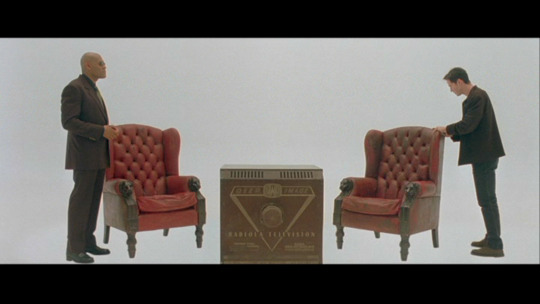
How can we describe “real”? How can we determine if it something is real or not? For something we see, smell, touch or feel, can we say that it truly exists? The answer is sure before I watched The Matrix.
The movie throws up an idea: a world of a deeply sophisticated and realistic dream, made out of a neural-interactive simulation which is called: the Matrix. Everything we see, we smell, we taste, we feel and experience comes out from the activity of our brain. Just as Morpheus says to Neo, the “real” we perceive is “simply electric signals interpreted” by our brains. So what if our brains are under control, and the electric signals we receive are manipulated? The world, everything we believe and trust in, that are built up on our senses crashes. What if we didn’t really see what we “saw” and feel what we “felt”? What if we are just lying in a prison of machines as bio-batteries? The idea becomes extremely daunting. Just as Neo seems hard to believe that the armchair he touches and feels isn’t real, the experience and understanding we have about reality has long rooted in our mind as some kind of basic rules. We live in the world with memories stores in our brains and we are the very pious believer of them. To me, the question of real is one of the major threads of the movie, which also has long been a philosophical crux.
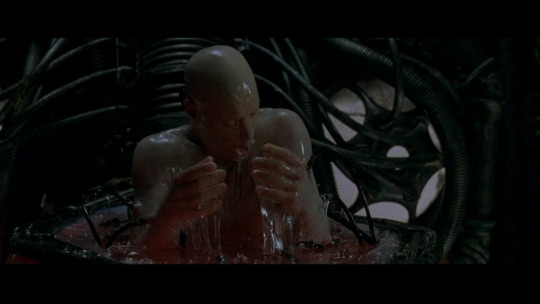
Just like dreams. in the movie, Morpheus puts it this way: “have you ever had a dream, Neo, that you were so sure was real? What if you were unable to wake from that dream, Neo? How would you know the difference between the dream world and the real world?” The answer is none. We can’t realize the fact that we are in a dream, until something goes wrong and disobeys our consensus, or we wake up. It reminds me of Inception by Christopher Nolan. How do we know if we are awake in our “real” life, or we are in a long realistic dream? When we wake up from dreams, are we truly “wake up”, or just enter another level of dream? Mal can’t distinguish dream from reality, and she becomes so skeptical that she choose to skill herself to “wake up”. Is she really dead, or she truly wakes up in another world? Just as the totem keeps spinning in the end, we never know. It seems that seeking and fighting for “real” is somehow meaningless, since the truth is nowhere. Morpheus explains to Neo for many times that it is our perception towards something that makes it real. Imagining eating beefsteak in the Matrix: the appearance it, the smell of it, the taste of it, the feeling of warmth and comfort it brings is the same as the real beefsteak, what’s the difference? People in the Matrix believe in the world they live in, so the beefsteak is real to them. The hard surface, the smooth polishing- the armchair in the Matrix is nothing less than the “real” world. Although it doesn’t exists in the world outside of the Matrix, but as reality is subjective, it doesn’t matter anymore- it is “real” or “unreal” at the same time. Seems ridiculous, but world has played this philosophy for a myriad of times.
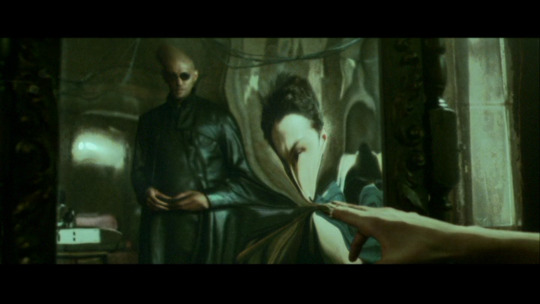
Just like electric signals are sent to human brains in the world of the Matrix, similar things are happening in our world. What we see on the internet, TV, or even newsprint, they run through our retina and turn to signals in our brain. For most of the times, photographs read real, videos are even more believable; the things that are made to store information turn to shape our perception towards the world around us. Are they faithful recorders of the real world? Hard to tell. But we are usually sure about them, because our life and experiences are built on this simple thinking mode, same logic as Neo believes what he touches is real.
The idea of simulacrum comes to play here. The line of real and unreal is not so clear anymore; in the world of the Matrix, the definition of “real” even ends nowhere. Maybe one day as the technology advances further, many things we consider unreal will be part of our real life, and we may doubt: is the beefsteak in my mouth real or not? Well, doesn’t matter.
0 notes
Text
Fight Club Analysis
To me, Fight Club is a movie questioning the true meaning of human and life.
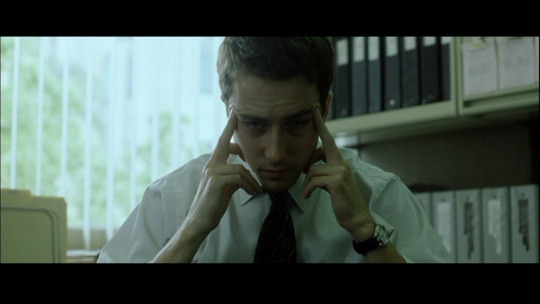
It is a world of capitalism and consumerism. The common philosophy is material and products. Jack, the protagonist is tortured by insomnia, with a head full of chaos. “Nothing’s real. Everything is far away. Everything is a copy, of a copy, of a copy.” He is so bored and dazed that by staring at a bin full of garbage, it turns to space junk in his mind. It seems that product defines everything. The type and color of his boss’s tie tells the day; browsing IKEA catalog and purchasing furnitures proves his existence; his job is applying formula. The core is vein. He loses his existence as his life and mind is shackled by the material world, which echoes the way he is weak and pale inside. But Taylor is different. He is brave and free. In my understanding, Taylor Durden is a personality that created by Jack (which we know in the end) as a way to escape from the swamp of his life. As Taylor said:
“You are not your job...you are not how much money you have in the bank...not the car you drive...not the contents of your wallet. You are not your fucking khakis. We are the all-singing, all-dancing crap of the world.”
Taylor believes that what defines human is not these outside worldly tags, but what inside us. He claims his belief through his obsession with pain, which reminds our existence: "It's only after we've lost everything that we're free to do anything.” Anything we have will ultimately fetter us, and to lose is to disconnect, to be free from the shackles. It actually corresponds to Jack’s reaction when he hugs Bob and immerses himself in oblivion. “I found freedom. Losing all hope was freedom.” The feeling of freedom and existence ignites and enriches Jack after fighting, which is the main thread running through. Dizzier, drooling saliva and blood is real. The sense of his own body takes Jack out of the boring material life into the rebellious violent world of Tayler Durden. But it is not a story of fighting. It is not fighting that brings back the true-self. The truth is always there, but people failed or just too afraid to face it.
There is a strongly inspiring speech by Taylor, says:
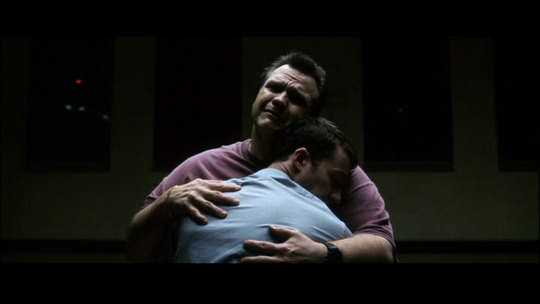
“Man, I see in fight club the strongest and smartest men who have ever lived. I see all this potential -- God damn it, an entire generation pumping gas and waiting tables; they're slaves with white collars. Advertisements have them chasing cars and clothes, working jobs we hate so we can buy shit they don't need. We are the middle children of history, man. No purpose or place. We have no great war, or great depression. Our great war is a spiritual war. Our great depression is our lives. We've all been raised by television to believe that one day we'll all be millionaires and movie gods and rock stars -- but we won't. And we're learning slowly that fact. And we're very, very pissed off.”

In this speech, Taylor emphasizes that a spiritual war is ongoing; the depression of lives is overflowing in our world. Just as Jack’s spiritual struggle and depression that keeps him from sleeping, it becomes a trend that hurts the whole generation. Jack describe how mundane people become slaves of consumerism, working without passion and buying things just to comfort themselves. We used to have dreams and goals, but we lost them. There is one scene that impacts me deeply, when Taylor brings a convenience store's clerk who named Raymond out at gunpoint, and questions “what did you want to be”. Raymond want to be a veterinarian, but now he is a clerk living in a “shitty basement apartment”. Is it reality that ruins his dream, or he himself just choose to give it up? Taylor forces Raymond to chase the goal to be a veterinarian again and let him go. “Tomorrow will be the most beautiful day in Raymond K. Hessel's life.” In front of death, Raymond is finally honest with himself.
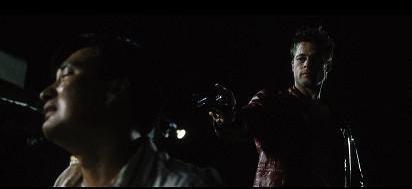
Why people are brave enough to do the things they want, or be finally free, only when they lost everything, or when they face their death? A lot of things keep us earth bound: order, culture, money, law, etc., but they are not even part of the ultimate reason. The reason lies in us.
I believe that Fight Club is not just fighting against the society, or capitalism, or consumerism; it challenges the mind, awakens the lifeless, seeks for freedom, and questions the truth. As Tayler says, the war is inside us: our spirits, our lives. You can choose to be slave with suits and tie, but there is always another possibility.
0 notes
Text
After Reading Simulacrum & Simulation
In this text, Baudrillard talks about the relationship between reality, simularca and simulation. The quote, “The simulacrum is never that which conceals the truth—it is the truth which conceals that there is none. The simulacrum is true.” is hard to understand at first, but it unveils itself as I move on. Simulacra depicts and represents something without a based reality. It’s more of a sign rather than a model; it’s more of a implication rather than imitation. Baudrillard uses the map of the Empire in Borge tale as an example, in which map was used to depict the kingdom at first, but then nowadays it is used as a reference of the territory. As Baudrillard says, it is the “precession of simulacra”. Even though, map is only a visual representation of the kingdom; map cannot show the substance of it. Here comes simulation, which is a model of the real-world. It is a machine that imitates the real operation of things.
Baudrillard explains how simulacra interacts and changes with reality by dividing the “precession of simulacra” in four stages. First one is a solid copy, a “reflection of a basic reality”, like the map mentioned above. Second one is a perversion of reality which is unbelievable and “masks and perverts a basic reality. As Baudrillard says, it is “an evil appearance. Thirdly, it becomes a representation without original, which “masks the absence of a basic reality”. It is believed to convey something real, but it is vein inside. Baudrillard claims that “it is of the order of sorcery”. The representation is vague and chaotic. It is neither relates to what it shows nor what may behind ti. And the fourth one is a standalone simulation which “bears no relation to any reality whatever: it is its own pure simulacrum.” It does not to be referential; it does not need to implicate some reality. It is a pure sign or a sign reflects other signs. Sign finally grows and becomes the reality. Artificiality is accepted by the mass and it thus becomes the “truth”.
In these stages, Baudrillard claims that the media challenges and blurs the line between simulation and physics reality. Disneyland is used as the example to explain the “entangled order of simulation”. At first it is a play of “illusions and phantasms” in the real world, where you park and enter, but you are slowly immersed in the air of affection, and the ideology turns to be a real thing. The simulation turns to be a real world. The question is no longer it is real or not. It is a concept of hyperreality, which is “neither true or false”. It refers to the blurry condition when one tries to distinguish reality from the simulation of reality. As Baudrillard suggests, Enchanted Village, Magic Mountain or Marine World all plays the philosophy of hyperreality. People are more into the “unreal” world rather than the real world outside. And somehow they choose to ignore the boundary of reality.
0 notes
Text
After Reading Cohen’s Monster Culture (Seven Theses)
What are monsters? They are so common in my cultural life, but the concept that defined them has never been thought and analyzed deeply as Cohen did in his “Monster Culture (Seven Theses)”. The ideas Cohen states are so intriguing that invites me to join his thinking, and the characteristics of monsters he suggested echoes with my understanding of monsters.
To me, monster is usually defined as something or someone “different” in bad meanings, either in its appearance, ability, or intentions. For examples, in the movie “Rampage”, these animals are just animals at first, but they are “monsters” as they become extremely huge in size (appearance); In the manga “Ajin: Demi-Human”, Kei Nagai is a hard-working student, but once he is discovered to be an “Ajin”, who has the ability to resurrect after death, people are afraid of him and they call him “monster” (ability); Joker in the Dark Knight series is considered as a “monster” because he just wants to “see the world burns” (intention). We are sensitive to creatures that are different from our consensus, and unknown is always associated with danger in our minds.
We define monsters, and the monsters are reflections of our concepts. As Cohen said, “the monster’s body is a cultural body”, a monster is formed with certain trends or feelings under a certain time period. Some monsters are like apocalypse; they are colossal with extremely destructive power like Godzilla, and they derive from our fear towards natural disasters or wars. Some monsters are humanoid with great strength and build, and they are usually deformed, such as Minotaur or Hulk; they are usually given birth by the imaginations of extreme human power as anti-heroes. Some monsters are like assassins: they hide, and their approach means death, such as Xenomorphs; they are the embodiments of our instinctive fear of darkness and unknown. Meanwhile, various monsters are created under different cultural trends. There is Headless Horseman in Middle Age Europe; Venom and Xenomorphs are created under our enthusiastic quest for the space. Cultural thoughts and emotions feed monsters, so their bodies are “cultural bodies”.
Cohen also concludes that monsters cannot be classified. From mythology to modern creations, monsters still hold on to this characteristic. Though some “monsters” are human in appearance, but they either don’t possess the humanity that we can relate to, or they have some social characteristics that we stand against; once they show emotions or thoughts that we are able to recognize and understand, they become no longer monster. In Blade Runner series, the Replicants are considered as monsters at first, but the sympathy and kindness they have change our minds. For more common monsters, they are creatures that challenge the wall of classification. They are either hybrid figures of human and animals, or creatures that don’t exist in the world. They are something that we are unfamiliar with; they are, as I mentioned above, “the embodiments of our instinctive fear of darkness and unknown”, which brings us to another thesis as Cohen writes: “the monster stands as a warning against exploration of its uncertain demesnes.” Just like the space exploration in “Prometheus” brings death and despair, “curiosity is more often punished than rewarded”.
“Monsters are our children”. It may sounds weird, but its a good metaphor that describes our relationships with them. Since monsters are reflections and embodiments of our ideas, desires and fears, they somehow become a mirror of society and humanity, and in this way they make us to look at ourselves and question our own minds. What makes Ajin or Replicants different from us? What defines them as monsters? What if human no longer unrivaled in this world? What if a man becomes a monster? How would we treat him? Monsters challenges our innate concepts and our perceptions towards “difference”. As a cultural phenomenon, we create them not only because they entertain us in cultural medias, but also because their unruled characteristic is the best challenger of our mundane world.
0 notes
Link
0 notes
Text
Analysis- Blade Runner 2049 Trailer
https://www.youtube.com/watch?v=gCcx85zbxz4&t=8s
Along with a deep growling electric sound, a misty futuristic city is shown with neon lights glowing afar. A lonely flying vehicle travels through a gigantic advertisement of Atari, which is a legendary pioneer of electronic entertainment in 1972. Somehow through these scenes, we can start to feel the loneliness, weirdness and emotional oppression in them.
The camera then switched to a mysterious room, in which the protagonist walks with a woman in a white suit, passing a set of strange human bodies floating in transparent boxes. “Every civilization was built off the back of a disposable workforce, but I can only make so many”- a man in kimono style clothes says, while a nude female body slipping down from a translucent pipe. The man gently runs his hand over the female’s face, who is trembling as the man says, “Happy Birthday”. It is not hard to capture the association that the female may be one of the disposable workforce that is just made by the man, for “civilization”.
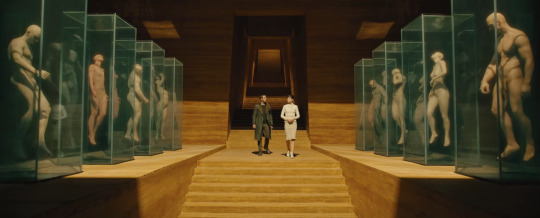
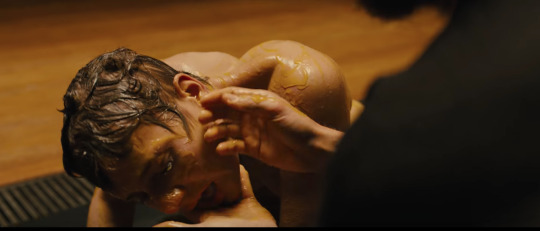
Greater electric music sounds like siren. The protagonist walks alone in a street of neon light and haze. The scene then switched to a military base; indoor, a woman says to the protagonist in a cold voice: “there is an order to things, that’s what we do here- we keep order”. We then can get that the protagonist belongs to the military base, who keeps the order, like cops or soldiers, and the woman is his superior. When she says “we keep order”, the scene changes to the protagonist holding a gun, with blood over his face- is it how “we keep order”? It leads to us thinking about the “order” that’s established: is it what the society truly needs, or it is something created to dominate under capitalism?
Then it comes to a misty street scene again. Two huge 3-D projections of ballet dancers dances in the middle of the street, labeled as “SOVIET HAPPY”. Neon lights and advertisements everywhere together with crowded people, all screams the possible future of late capitalism. On a raining rooftop, a girl slowly walks towards the protagonist, who may be his girlfriend, while the voice of the superior goes on: “The world is built on a wall that separates kind. Tell either side there’s no wall, you bought a war.” What are the kinds that are separated? Referring to what’s presented earlier, it may mean that “people” created by human are considered different, and the wall between human and “disposable workforce” is crucial. Is the wall really exists, or are they hiding the truth?
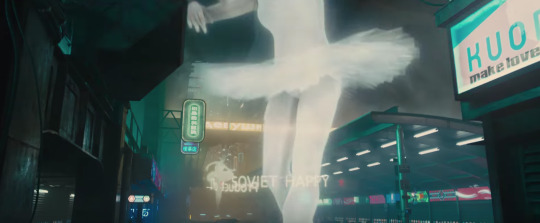
Next scene, the protagonist walks in a desolated land covered in orange dust, passing some giant statues which are somehow strange and erotic, and steps into an old-style grand hotel. He comes here for a man who is his predecessor and may hold the key to the major conflict.

Then some montage sequences flash: the protagonist driving alone and an advertisement labeled “JOI” is reflected on his window; some women dressed in old punk style walks towards us; a flying car passing a land of waste; a giant 3-D projected woman interacts with the protagonist, who looks exactly like his “girlfriend”; a 80’s style bar with whimsical lights; another advertisement of “JOI” showing a woman, who appears to have the same looking as his “girlfriend”; some fighting shots, and it ends with a close up of a green eye opening up. It turns to a scene in which the girl says to the protagonist: “I always told you, you’re special.” Clues from these shots imply that the girl may actually be a commercial product instead of a living person, and what does it means by her saying that the protagonist is special?


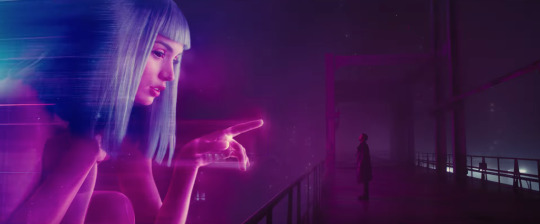
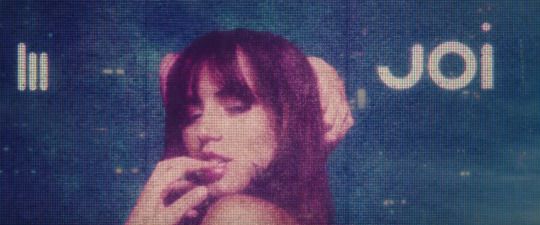
The trailer shows a great mix of culture, either eastern or western, high or low, and even cultural elements from different time. It challenges towards the concept of humanity and order, throwing questions towards ethics when everything can be a manufactured product of capitalism. The future it shows is full of pollution, overcrowding, entertainment, and over-commercialization, and it doubts what technology brings as it advances.
To find the answer, go watch the movie.
0 notes
Text
Summary- Thinking With Others
In this video, Rugnetta throws up an idea: it matters what stories tell stories. It matters what ideas we think other ideas with. He starts with “people”, which relates to Idea Channel. He explains that by doing comment responses, he wanted us to have interaction with him, thus include different perspectives which may change his mind. This system was inspired by Grace Helbig’s "Commenting on Comments" and also by "The Brian Lehrer Show," where Brian takes calls on topics from whoever cares to call in. Rugnetta then brought it to YouTube.
Back to the main theme. Though the impetus in discussing pieces of popular culture mainly comes from its fans or its detractors, we still focus on pop culture through its impact on audiences. Why? To explain why we did all this, he talks about critical empathy, which starts from explaining it.
It begins with the term “critical thinking”. What is critical thinking? Rugnetta quoted the words of philosophers Michael Scriven and Richard Paul, saying that critical thinking contains many kinds of thinking with different aims and can be used in various disciplines. He then talks about what unites them, quoting Linda Elder, who claims that intellectual virtue makes critical thought.
The process of thinking critically involves people thinking about things, thinking about themselves thinking, and adjusting their thoughts in order to make themselves better in the future. Critical thinking actually requires you to be aware of yourself, not erase it. It's not about being objective; it’s about being honest. Critical thinking requires humbleness to others’ ideas with understanding.
As Rugnetta points out, critical thinking is also a way to grow; in terms of Idea Channel, his perspective changed and grew as the show changed and grew. He emphasizes that the conversations around Idea Channel shaped him, and maybe also lots of audience of the show. We gained a lot throughout this process.
Although one may regard thinking with or about other people as not critical thinking, considering the use of experiences and feelings as irrelevant, Rugnetta strongly believe that the respect and use of the feelings of others is often required for critical thinking; in Ideal Channel, we're thinking about pop culture and theory, but also people.
Thus he moves forward to critical empathy, of which he quotes the definition by DeStigter: It includes appreciating the experiences and life of others, trying to find the connection and then using that knowledge to think about and interact with the world. Then Rugnetta introduces how Elbow describes the two “games” to support his point. The first, called "the doubting game,” means looking for flaws in our understanding of the world and the understanding of others, which is also what most people think of critical thinking. Adding to it, there is "the believing game,” which is trying to be as accepting as possible to every idea we encounter. ”The doubting game is the rhetoric of propositions, while the believing game is the rhetoric of experience.” As what is in Idea Channel, the believing game is a way for us to practice critical empathy, which Rugnetta encourages us to continue our pursuit; he encourages us to think with one another to help us learn and grow; he encourages us to believe someone with an idea, especially different ones.
As he concludes, we should make use of pop culture, and though Idea Channel is done we should continue to think with and about one another.
Rugnetta’s opinion really works for me. He first explains why we care so much about pop culture, which is discussed in his last episode, and focuses on critical empathy. We are often times trapped by our own strong opinions, and how he understands critical thinking really encourages us to accept and think with others. As what I have experienced, believing and understanding always leads to a broader view of the world.
0 notes
Text
Summary- A Defense of Overthinking Pop Culture
In this video, Rugnetta points out that popular culture is “an abstract location where values are secured and challenged”, and Idea Channel wants to give us something to use or even argue against in our own life.Then he starts to argue why he think pop culture is intellectually important and why we overthink it.
There are four common opinions against overthinking that he think are vacuous. First is that all necessary meaning contained in a work is broad and lying on the surface. Second is that trying to find deeper meaning leads to opinion instead of fact, we should only look for what’s verifiable. Third, who created the thing don't intend viewers to find unverifiable significance. And fourth, spending time on this is meaningless, we could have done something more meaningful.
Standing against these comments, Rugnetta claims that nothing is just itself, considering the social, economic, and cultural impact of media; meaning and significance are personal and dependent on individual’s experience; meaning is not objective, which makes it interesting and useful; the meaning found in media is often unexpected or unintended by creators but still part of the work; finally, such pursuits are useful, powerful tools in deepening one's experience of the world.
He further points out that pop culture works actually contain philosophy because they connect to their viewers. By quoting the words of Gilles Deleuze, Stephen Mulhall, Costica Bradatan and Jordan Erica Webber, that films and games are philosophy in action, Rugnetta strengthens his point.
No only thoughtful works do philosophy, but Rugnetta claims that all media is capable of potentially philosophical work.
He first give the definition of pop culture: it is “media and goods which are available to the masses”; then he argues how popular culture is considered as low culture for many times. Though the distinction still exist now, it's getting increasingly harder to identify. Popular culture contains artful elements, and high-low culture mix. He offered some examples, such as how James Turrell and Jay Z collaborated. He then concludes that pop culture is a kind of abstract location where many seemingly contradictory cultures meet, interact, and get passed around.
Secondly, he talks about why it's worth overthinking. Popular culture makes personal stories available to the masses. Such as "Moonlight" can help different people share an experience and discuss their reactions. "Game of Thrones" helps us develop a common language for understanding what it's like to be a unique human. They help our understanding grow. We we get various meanings based on different contents and diverse experiences.
But there is a conflict between producer and consumer. The producers of popular culture is powerful and influential in social, cultural, economic, even moral because they decide the environment around us. Any piece of popular culture is a statement about the world, which is philosophical. Thus he suggests that overthinking is a worthwhile pursuit as a way to study the culture defined by who produce it, especially popular culture for its richness, pervasiveness, and influence. Overthinking refines our relationship to our own culture and encourages us to discover more about it; Rugnetta believe such pursuit contains values. Pop culture triggers discussion among great mass of people who otherwise may not interact. What’s more, in this way we can work towards determining which facets of that culture are worth securing and which we must challenge. That is why we overthink.
The argument Rugnetta makes in this video is strong and solid; it relates to my own experience. Some times I am really touched by the works of pop culture, such as “My Hero Academia”, and I find the meaning in my own way. Through discussing with others about it, I think more about myself and the work, even the culture behind it. To me, it’s really beneficial to “overthink”.
0 notes
Text
Summary- What Are Ideas, and Who Gets to Have Them?
The first topic of this video is “ideas”, specifically what they are and who gets to have them.
When someone says that he has an idea, what follows is likely to be something unexpected, which is no obvious or boring, and it leads to thinking. This kind of idea is defined as complex idea: the novel combination of one or more pre-existing ideas. We often start with something familiar and try to combine it with something. Rugnetta mentioned that in the Idea Channel, he also begins with something that’s more common but not those impactful ideas, such as “liberty”, “evil”, “popularity”, “violence”, “religion” and so on. These ideas are called concepts.
Not only philosophers and theorists, we also work with concepts. Rugnetta emphasizes that everyone confronts concepts in some ways, including world events, personal experiences and media. Many impactful concepts are hiding in our world. And he encourages us to look for those impactful concepts in even many common things, and we will make everyday more exciting and find it more and more useful- “you become a more powerful agent of experience and thought in your everyday life”. Rugnetta points out that his and Idea Channel’s aim is to reveal the relationships between concepts, media properties or series based on his observation, which gives the show a clear grounding. He further states that, the ultimate goal of Idea Channel is to encourage conversations about his own observations. It’s OK to have a different perspective, just write a comment.
The next topic is that, who gets to have ideas(complex ideas). Not just experts or the elites, everyone gets to have ideas, though not that straightforward. Rugnetta then talks about two challenges to create a situation where everyone feels welcome to engage with this complex thinking process.
He introduces two French philosophers, Jill Deleuze and Selig Watari. In their book, they say that, “don't read the book, use it!” As the translator Bryan Masumi suggests, the book is not a brick but a toolbox.To show the interconnection of the world, in the book, ideas are not built with but used, which Deleuze and Watari call it nomadic thought, which, as Rugnetta states, is his model for lots of his work, and also idea channel.
Our thoughts move around fast and often randomly, and we use whatever ideas even in ways not intended or expected while preserving the sense of dynamism. Rugnetta further encourages us to worry less about building and more about using, exploring, testing, and do it together in conversation.
Nomadic thought is one of the guiding principles for Rugnetta to treating idea channel like a conversation, to make the nomadic interconnected ideas be comprised of both his and viewers’ ideas. He hopes that Idea Channel continues to influence the viewers after it ends. “Don't worry if it's right before having an idea, have it first and then decide.”
In this video, Rugnetta logically suggests what are ideas and how they are formed by people, which echoes with my daily experiences. Complex ideas are not born from nothingness. They are formed and shaped from random thinking, and many times as I often find out, they come from conversations, from “nomadic thought”.
0 notes
Text
After Reading “You Say You Want a Devolution” By Kurt Anderson
I agree with Kurt Anderson’s idea that during the past 20 years, there is a stagnation in the creation of new cultural aesthetics.
In the article, Kurt Anderson offers a strong argument with solid evidences to support his points. He suggests how in multiple cultural fields, including music, literature, architecture and fashion, there is hardly any freshness during the years. People may have trouble distinguish new creations form which was born in the past. As he mentioned, “the Aeron chair in which you’re sitting is identical to the Aeron chair in which I sat almost two decades ago, and this morning I boiled water for my coffee in the groovy Alessi kettle I bought a quarter-century ago. With rare exceptions, cars from the early 90s (and even the late 80s) don’t seem dated.” While pointing out how cultural aesthetics comes to a standstill, he gives two possible reasons behind this: relentless innovations tired us, and growing capitalism. At last, he questioned if American culture will be active again, or declines in silence.
Just as what I perceive, the trend of art stopped radical movement, or it moves in a speed that’s too slowly for me to realize. Actually, most of our current aesthetics are based on the past and shackled by the current.
This phenomena is particularly acute in concept design for sci-fi movies and games. “Cyberpunk” is one of the hottest theme in entertainment products, which even somehow shaped our tastes towards sci-fi works. However as we look back, decades have pasted since the first screening of “Blade Runner” or the publishing of “Ghost in the Shell”. So many movies and games are created under the common idea, such as “Robocop”, “Cyber City Oedo 808” or even “Matrix”, and they are still emerging. Though time passed and the theme lost its freshness, the aesthetics of cyberpunk thrives and continues to influence the current entertainment market. We are still creating works that are very much like the concepts from decades ago, despite the development of technology (such as special effects).
“How scientific/ hardcore should the design be” has always been a parameter defining a conceptual world. There used to be unconstrained and even crazy designs when people try to depict the future, such as “A Trip to the Moon”; however, now almost all the sci-fi movies and games are running towards the common destination of reasonableness. We become much more conservative in conceptual creations. Arguments always emerge when some designs appear to be unrealistic, and we praise reasonable designs. Thus, hardcore designs dominated the market for 10 years. Maybe the reason behind this aesthetic inclination is, as Kurt Anderson points out, “an unconscious collective reaction to all the profound nonstop newness we’re experiencing on the tech and geopolitical and economic fronts”. Even in movies or games, we prefer seeing designs that make more sense to our eyes and minds. It may not shock us, but it offers a feeling of comfort. “How things work” is what we are looking for. And this philosophy also works on the economic side, as “our massively scaled-up new style industry naturally seeks stability and predictability”, certain type of entertainment design is favored and boosted.
Although the stagnation is real, I still have great faith in the culture we are immersed by; I still have great faith in people’s creativity, which has no boundary.
0 notes